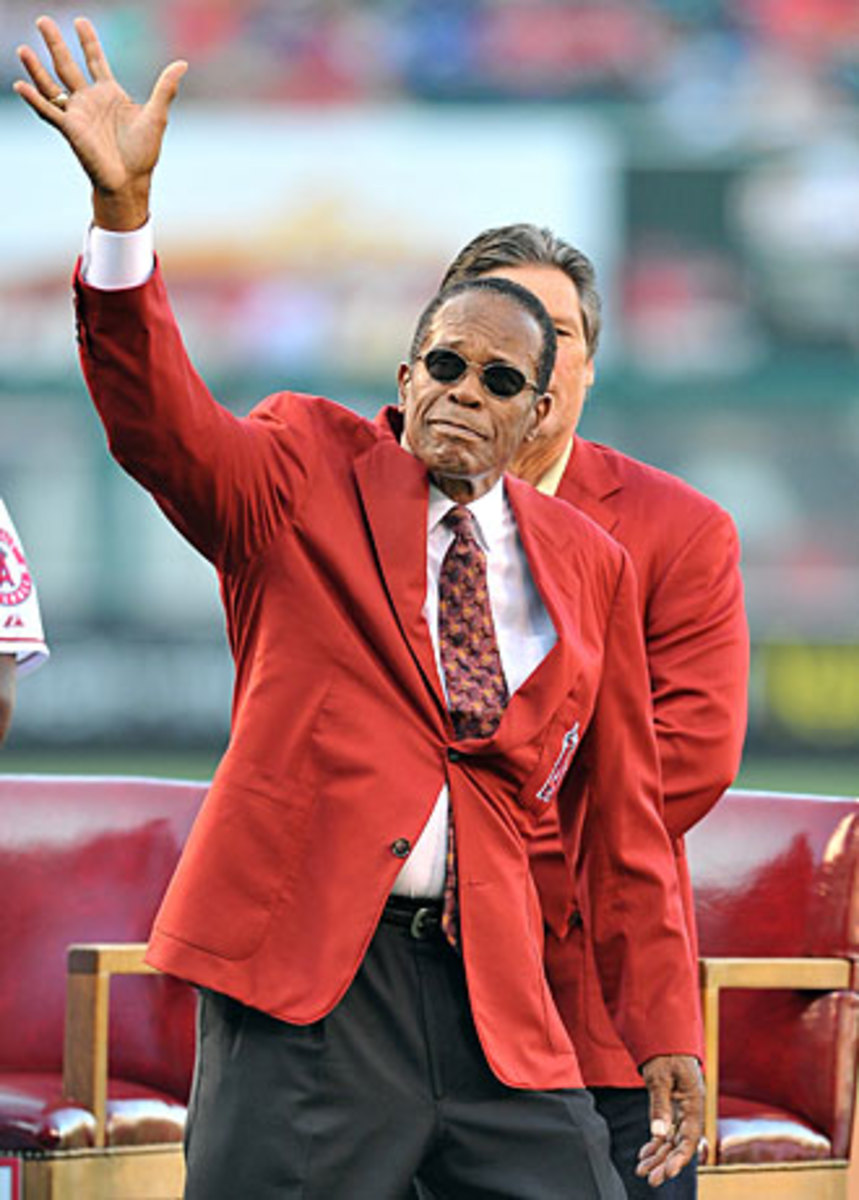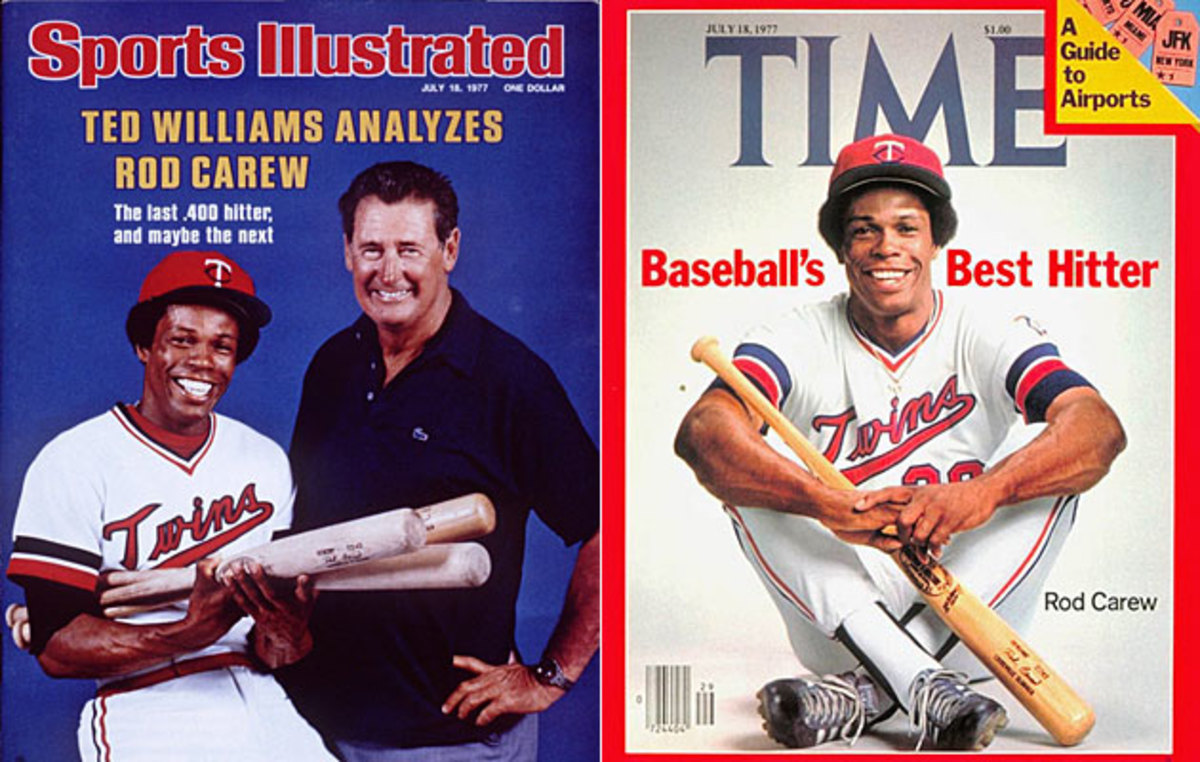Rod Carew opens up about his private life and his near-death experience

SAN DIEGO — Playing alone at Cresta Verde Golf Course in Corona, Calif. on the sunny Sunday of Sept. 20, Rod Carew hit his drive off the first tee precisely where he drove so many of his 3,053 hits with the Minnesota Twins and California Angels: “Right down the middle,” he says.
It was 11 days before his 70th birthday. Stepping off that tee box, Carew suddenly felt his chest burn and his hands go clammy. Retreating to the clubhouse, he lay on the floor and asked a woman there to call a paramedic. “The next thing I saw was a man with paddles in his hands,” Carew says. “He was yelling, ‘We’re losing him! We can’t lose him!’ Then I blacked out.”
When he woke in the emergency room at Riverside Community Hospital—to more paddles and more shouts of “Don’t lose him!”—Carew closed his eyes again. “I decided to go to sleep,” he says softly. “And I didn’t know if I’d wake up.”
He had suffered a massive heart attack—“the kind they call the widow-maker,” says his wife, Rhonda. And though doctors told Carew he was extraordinarily lucky to be alive—his heart had stopped beating on two separate occasions—he doesn’t always feel fortune-kissed. “My wife will tell you I get up in the morning and cry and wonder, Why me?” Carew says, convalescing in a friend’s house in the suburbs of San Diego after seven weeks in five hospitals. “But you can’t say that. I go back to when my youngest daughter was dying. I never asked my friend upstairs, Why me? And He’s the only one who has the answers.”
Carew is sitting in an easy chair. Minx, a black Bombay cat, is perched above his right shoulder. Both exude a quiet grace—they look equally feline in repose—and there’s a brief silence in the house as Carew considers that a kind of mechanical heart has been implanted in his chest, alongside his damaged one. After a moment, the most elegant hitter of his generation puts his face in his hands and sobs.
“I was dead,” he says, “and they brought me back to life.”
*****
No man was ever more at peace in a batter’s box than Carew, who gripped the bat ever so gently, as if squeezing icing onto a cake. “Relaxed” is how he describes the feeling of awaiting a Nolan Ryan fastball. “With baseball, I could get away.”
As a child, Carew was routinely beaten by his father. At 50, he lost his 18-year-old daughter, Michelle, to leukemia while she waited on a bone-marrow transplant list. His first marriage, to Marilynn Levy—the couple have two daughters in addition to Michelle—didn’t survive that tragedy. It was only between these agonies, while bedeviled by a fear of flying, that Carew was the man you thought you knew: a batter of unsurpassed calm and beauty.
But the man who resembled a Shaolin monk at the plate, who appeared to slow his own heartbeat with his mind, has at times lived a life of near-Biblical trials. “Rod will tell you he had his heart attack because he stopped taking his Lipitor,” says Frank Pace, Carew’s close friend and business manager. “But he has had many stresses in his life.”
And so Carew now has something called a Left Ventricular Assist Device (LVAD) pumping blood on his behalf. It was installed, in a six-hour open-heart surgery, at Scripps La Jolla hospital by Dr. Dan Meyer and Dr. Sam Baradarian—“The Barbarian,” as Carew’s 26-year-old son, Devon, says with enormous affection for all the medical professionals who saved his dad's life.
“Ten years ago,” Rhonda says, “Rod would have been dead.” But he survived the arduous, open-heart implantation of the LVAD, which typically acts as a bridge until a patient can receive a heart transplant.
“It’s a big surgery, but it is very clearly working,” Dr. Mariell Jessup, Professor of Medicine at the Hospital of the University of Pennsylvania, says of LVAD procedures generally. “We are not watching people die on the [transplant] waiting list.”
Some patients keep the LVAD permanently when transplantation is not an option. At 70, Carew is near the age border for a transplant, though age standards are considerably more liberal in the western United States, where waiting lists are shorter. “I don’t know if I’m going to be bionic or what,” says Carew, who is concentrating now on becoming healthy enough to quality for the transplant list.
The case for the Kansas City Royals for SI's 2015 Sportsman of the Year
He’s off to a promising start. On Nov. 5, Carew became the fastest patient ever released from LVAD rehab at Scripps Memorial Hospital Encinitas. He unzips his FBI SWAT team vest to show off his new lifeline, which consists of a small computer controller worn on his waistband and two battery packs tucked inside the vest. He lifts his shirt to reveal tubes running from the battery pack to the controller and from the controller through his abdomen into his chest, where the LVAD pumps blood to his own heart—from his left ventricle into his aorta.
At night, he plugs his device, and by extension himself, into a wall socket, like a Chevy Volt. Just inside the front door—so he never leaves home without them—he keeps a supply of spare batteries and LVAD controllers in a bag the Carews have come to call “Honey.”
“They told us to name the bag,” says Rhonda, “and to treat it like a member of the family.”
As for the human members of his family, their love moves Carew daily to tears. “She’s everything,” he whispers when Rhonda leaves the room.
“My son and my wife have been my nurses since all this happened,” he says. “It surprises you about people. My son, Devon, he cleans me up and puts me on the toilet. And I’m thinking, This kid really loves me. He cares about me. My wife does the same thing. Where do people get that sense of wanting to help others in distress?”
“The same place you got it with Michelle,” Pace says.
These simple acts of hygiene have become profound, the embodiment of familial love. When his own father whipped him with a cord as a matter of routine, Carew wondered if he could ever grow up to be a good father himself. Sitting across the room, his son can’t help but hear this.
“You were a good dad,” says Devon, whose mother, Rhonda, married Carew 14 years ago. “You are a good dad.”

Devon has seen the public’s love for his father transcend baseball. Carew has been name-checked in songs by the Beastie Boys and Adam Sandler. Pace tells him, “There’s a Rod Carew Drive in Round Rock, Texas,” which comes as news to this Rod Carew, whose ego is not enlarged by such honors. He calls the bronze statue of himself outside Target Field in Minneapolis “a place for birds to poop.”
“We were coming through security at [Los Angeles International Airport],” Devon says, “and the guy there asked Dad if he knew what a ‘Rod Carew’ was on Urban Dictionary.” (It’s a vulgarism that involves going from first base to third base without touching second.) Rod shakes his head in mock dismay upon hearing this, like a put-upon dad in a sitcom, which he often appears to be.
“When he’s getting ornery,” Rhonda says, “we know he’s getting back to normal.”
The Carews have embraced these moments of comedy in the last two months. When the LVAD was installed, doctors told Carew he could do everything with it but swim or arc weld. Rod, whose indifference toward swimming is exceeded only by his apathy for arc-welding, shook his head in faux despair. “No arc welding?” he says now with a sigh.
This banter, as much as his batteries, fuels him now. His physical therapist, Alan Vuong, has Carew doing tai chi and urging him to enjoy every sip of water, to concentrate on every bite of apple. “We treat him holistically,” Vuong says, “with body, mind and spirit working together. And we’re seeing huge progress. The heart can last forever, or as long as the mind lasts.”
“I have to start enjoying this more,” Carew says, “instead of sitting around doing nothing.”
While Carew slowly climbs the stairs as part of his therapy—the handrail is on the left—Vuong asks him which hand he is. Carew answers that he’s righthanded, never letting on that there are two conspicuous exceptions: He swung a baseball bat lefthanded (winning seven American League batting titles, his dominant right eye closer to the pitcher) and he swings a golf club lefthanded (making seven holes-in-one as a 12 handicap).
Vuong confesses that he’s not a baseball fan and had to Google the name “Willie Mays” when a colleague excitedly showed him the Say-Hey Kid’s autograph. On hearing this, Carew gazes into the distance with a look of deep amusement.
Then he tells a story. Not long before his heart attack, he was visiting the batting cages near his house in Orange County. He does this from time to time, offering gentle pointers, like Leonardo da Vinci dropping in on a grade-school art class. When he saw a seven-year-old facing 70-mph pitches from 60 feet away and suggested to the boy’s father that he reduce both the speed and the distance of the pitches for his son, the father suggested that Carew mind his own beeswax.
Just then an older kid walked by and said: “That’s Rod Carew!” Life seldom offers such tidy satisfaction.
“The guy apologized up and down,” says Carew, laughing.
*****

Early in his career, Carew visited a Minnesota hospital at the insistence of Twins owner Calvin Griffith; a nine-year-old boy wanted to meet his hero. “He’d been burned severely,” Carew says. “And when I got there they were scrubbing him. And he was screaming. And when he saw me he said, ‘Don’t get mad at me, Mr. Carew, but it hurts. It hurts.’ The kid was scarred for the rest of his life and he was worried about me hearing him cry. Well, I just turned to the window and started crying.”
After that, he visited children in hospitals whenever he could. In 1977, he won the Roberto Clemente Award as baseball’s exemplar of community service. He has seven silver bats and the 1977 AL Most Valuable Player award, but the Clemente award is the one he shows visitors. “I’m supposed to be this big guy,” he says. “But I cry a lot.” When the Twins traded him to the Angels in 1978, he cried.
It is no wonder, then, that the handful of friends in baseball who know of his plight have comforted him in turn. Former players like Don Baylor, Johnny Bench, Doug DeCinces and Chili Davis have visited or called. So have Twins president Dave St. Peter and Angels president John Carpino. Carew’s advisory contracts with both teams expired 10 days after his heart attack, and both teams renewed him for 2016. Jeff Idelson, president of the Baseball Hall of Fame, has been poised to notify Carew’s fraternity brothers in Cooperstown whenever the first-ballot Hall-of-Famer was ready to go public.
That moment is now. Carew is speaking publicly for the express purpose of inspiring others who may require LVAD surgery or heart transplantation, and to urge the rest of us to be more rigorous about heart health. “The first thing that went through my mind,” he says of his unlikely survival, “is I have to get this message out to people.”
And so he has had the profound decency to reveal himself at his most vulnerable. He will help the American Heart Association do the same kind of advocacy he practiced for those leukemia patients who needed bone-marrow transplants when Michelle died in 1996. Their story increased registrants to the National Bone Marrow Registry, saving untold lives.
Indeed, the night before his heart attack, Carew participated in a fund-raising walk for leukemia research at the ballpark where he was once an Angel and remains a kind of angel. “You are here for a reason,” Rhonda tells Rod, repeatedly. “The Lord wasn’t ready for you yet. He kept you here for a reason.” Whatever that reason is—whatever the meaning of his life—baseball is beginning to look like only a small part of it.
Even so, baseball is integral to his recovery, and Carew has set goals to attend spring training in March and the Hall of Fame induction weekend next July, as Rhonda frequently reminds him. “She’s like a drill instructor,” he says. The man who used to call the weather bureau before every road trip can finally sleep on planes now, freed from teammates throwing their pillows at him during turbulence, as they used to enjoy doing “just to rattle me.”
At the peak of his powers in the summer of 1977, a year in which he hit .388 for the Twins and made the covers of Time and Sports Illustrated in the same week, Carew received standing ovations nearly every at-bat, a memory that edifies him even now.
“I’ll never forget that love,” says Carew, whose friends hope he’ll throw out a ceremonial first pitch next spring, and be buoyed by a ballpark ovation yet again. For Rod Carew knows better than anybody: There are many ways to fill a human heart.
